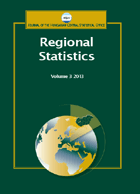Regional taxable capacity measurement methodology
based on factors that determine tax gaps based
on the example of the Republic of Dagestan
Regional taxable capacity measurement methodology
based on factors that determine tax gaps based
on the example of the Republic of Dagestan
Author(s): Ramazan Magomedovich Magomedov, Khadzhimurad Arturovich Israpilov, Olga Yuryevna Gorodetskaia, Svetlana Magomedovna Doguchaeva, Anatoliy Vasilevich Zolotaryuk, Olga Nikolaevna TSVETKOVASubject(s): Social Sciences, Economy, Geography, Regional studies
Published by: Központi Statisztikai Hivatal
Keywords: taxable capacity; measurement methodology; tax gap; integral indicator; shadow sector of the economy
Summary/Abstract: Background: This paper analyses the existing methods for measuring a region’s taxable capacity and presents the authors’ proposed approach. Objective: The paper’s objective is to develop a method for measuring a region’s taxable capacity which could significantly increase accuracy in tax revenue predictions. Methods: Comparative and situational analyses, as well as expert evaluations are applied. Findings: A method for measuring regional taxable capacity is developed based on tax gap figures. This study specifies and supplements a method for evaluating a region’s tax potential using the indicators that determine a tax gap. Unlike well-known approaches, this method can significantly improve the evaluation’s reliability and accuracy, and allows identification of opportunities in order to grow the tax revenues of sub-federal budgets. A comparative analysis of the results of evaluating the taxable capacity of the Republic of Dagestan using different methods shows that the highest value is its tax potential, which takes the tax gap into account. This suggests thatthe real tax potential is not fully realized and there is room for development. Conclusions: The measurement methodology used to determine a region’s taxable capacity involves an integral indicator, which is composed of private parameters. The final measurement indicator should be based on criteria that can be represented by a number of qualitative indicators. These criteria should accurately and completely determine the actu-al taxable capacity of a region.
Journal: Regional Statistics
- Issue Year: 9/2019
- Issue No: 02
- Page Range: 173-189
- Page Count: 17
- Language: English

